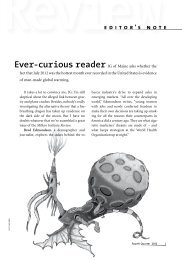The Rise and Fall of the U.S. Mortgage and Credit ... - Milken Institute
The Rise and Fall of the U.S. Mortgage and Credit ... - Milken Institute
The Rise and Fall of the U.S. Mortgage and Credit ... - Milken Institute
You also want an ePaper? Increase the reach of your titles
YUMPU automatically turns print PDFs into web optimized ePapers that Google loves.
Introduction<br />
For generations, <strong>the</strong> mortgage market has efficiently <strong>and</strong> successfully extended credit to millions <strong>of</strong> families,<br />
enabling <strong>the</strong>m to achieve <strong>the</strong> American dream <strong>of</strong> owning <strong>the</strong>ir own homes. Indeed, <strong>the</strong> homeownership rate<br />
reached a record high <strong>of</strong> 69.2 percent in <strong>the</strong> second quarter <strong>of</strong> 2004. <strong>The</strong> growth <strong>of</strong> subprime mortgages that<br />
contributed to this record, moreover, meant that many families or individuals deemed to be less creditworthy<br />
were provided with greater opportunities to purchase homes.<br />
Unfortunately, a system born <strong>of</strong> good intentions veered horribly <strong>of</strong>f track, derailed by poor risk-management<br />
practices, too many assets funded with too little owner-contributed equity, <strong>and</strong> lax regulatory oversight.<br />
In <strong>the</strong> past, <strong>the</strong> vast majority <strong>of</strong> mortgages were more carefully vetted <strong>and</strong> extended on more stringent terms by<br />
neighborhood savings <strong>and</strong> loans, institutions that originated, held, <strong>and</strong> serviced <strong>the</strong>se loans throughout <strong>the</strong>ir<br />
lifetimes. But in recent years, <strong>the</strong> mortgage industry increasingly moved toward securitization (that is, packaging<br />
mortgages into securities <strong>and</strong> selling <strong>the</strong>m into <strong>the</strong> secondary market, <strong>the</strong>reby shifting credit risk).<br />
<strong>Mortgage</strong> debt<br />
$10.6 trillion<br />
Equity in housing<br />
units $8.7 trillion<br />
Figure 1: Value <strong>of</strong> housing units: How much has been borrowed,<br />
who are <strong>the</strong> borrowers, <strong>and</strong> who funds <strong>the</strong>m? (Q2 2008)<br />
Total value <strong>of</strong> housing<br />
units = $19.3 trillion<br />
Subprime<br />
8.4% Securitized<br />
59%<br />
Prime<br />
91.6%<br />
1<br />
Nonsecuritized<br />
41%<br />
Governmentcontrolled<br />
46%<br />
Sources: Federal Reserve, <strong>Milken</strong> <strong>Institute</strong>.<br />
Note: <strong>The</strong> share <strong>of</strong> mortgage debt that is controlled by <strong>the</strong> government <strong>and</strong> by <strong>the</strong> private sector is based on Q3 2008 data.<br />
Private<br />
sectorcontrolled<br />
54%















